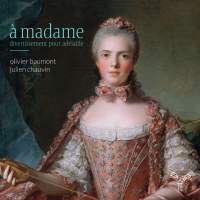Texte paru dans: / Appeared in: |
|
|
Outil de traduction ~ (Très approximatif) |
|
|
Reviewer: Barry
Brenesal
The madame of the title is the
Princess Adélaïde, fourth daughter of Louis XV and Marie Leszczyńska of
Poland. She was by several accounts learned in the arts and beautiful in
appearance, but also supercilious, domineering, and given to snap judgments.
Several of the works on this album were dedicated to her, including two
composed by Simon, and the one arranged by Guignon. Jean-Baptiste Cardonne
in turn was described as an officier de la chambre de Madame, meaning that
he was on her personal staff, probably as a composer and performer. Matters
grow more tenuous with the other composers included here. Dauvergne edges
in, presumably because he was Simon’s teacher in composition, while Rameau’s
music, we are told, was occasionally heard at Versailles over the years in
various chamber arrangements. Balbastre was a protégé of Rameau. The
inclusion of Dauvergne, Rameau, and Balbastre doesn’t make for convincing
logic, but it does raise the overall quality of the album’s music
significantly.
For, though Simon Simon was an
expert social climber described as possessing graceful manners and great
personal charm, both his First Concert in A Major and the maestoso movement
from his Sonata IV show just how much damage was done to the average level
of French music by the triumph of the Italian style. With his sewing machine
accompaniments, bland motto themes, and an impoverished harmonic vocabulary,
Simon wrote works that are of scant interest. Only the final allegro of the
First Concert rises to a higher level, by dint of not at all taking itself
seriously. It is one of those skipping finales that proved popular in late
18th and early 19th century France—harpist François Joseph Naderman was well
known for his—with a frivolous rondo theme, and a very brief but interesting
turn to the minor in its countertheme to add just a bit of distinction. Dauvergne’s Sonata XII, on the other hand, reveals the strong influence of Corelli, though his minuet finale returns to France. Balbastre’s aria gratioso is also a minuet, and once again, very French. The first movement of Cardonne’s Sonata VI in F Major moves past the galant to display a fairly complex sonata structure, even if the material and its treatment aren’t usually interesting. The third movement finale is, yet again, a minuet, and the most virtuosic of the lot on this album. As for the Rameau, Guignon’s version of Les sauvages is a technically adept and virtuosic arrangement that has justly drawn the attention of violinists in this repertoire. Benaut’s three pieces from Castor et Pollux as reduced for harpsichord, on the other hand, simplify the left hand accompaniment. Rameau’s celebrated batteries remain in the Overture, but the arranger introduces an Alberti bass in the middle of the fast fugal section. Exile was applied for lesser crimes than this one.
Three cuts remain to be
discussed that contribute nothing to the album as music. One, at the
beginning of the album (and repeated at the conclusion of Cardonne’s
sonata), features the single note chimes of a tableside clock currently in
the restored drawing room of Adélaïde’s sister, Victoire. The other two are
single-voiced, minute-long pieces of no distinction performed on mechanical
clocks once owned by another member of the royal family. These all serve to
reinforce the emphasis in this release on physicality, with its liner notes
that linger at length over descriptions of the apartments of the sisters:
their portraits, the clock’s appearance, the furniture, and more. It all
produces a curious effect of reducing the world of Adélaïde and her sisters
to nothing but their drawing rooms—as opposed to utilizing extent research
to establish a broader context that would give us some idea of their
emotions, thoughts, and habits, and their daily changing ways of interacting
with their large and complex world. The performances are usually expert, which is not unexpected, given the skill of both performers. What is perhaps a bit surprising is the unexpectedly sluggish tempo that Olivier Baumont adopts in the Castor et Pollux Overture, which robs the piece of much of its brilliance. Elsewhere, he is as adept as ever. He phrases supplely, and administers ornamentation with a careful hand. Chauvin, too, gets his chance to solo in Rameau, though perhaps the term duo would be more appropriate, since he overdubs himself in the Guignon Les sauvages arrangement. It has a similar swagger and technical expertise to the piece’s recent performance on another album reviewed in this issue, Age of Indulgence by Les Délices (Navona Records 6098). I do find the latter a bit better, however, because of the minor tonal differences produced by violinists Julie Andrijeski and Karina Smith. The engineering is very close and slightly over-reverberant for the violin. Baumont employs an attractive François-Étienne Blanchet harpsichord of 1746, with a rich, carefully modulated sound between treble and bass. Chauvin uses the Adélaide violin—yes, the one for which Marius Casadesus, that master of marketing, fantasized a history and wrote a fake Mozart concerto. That aside, it is a Gagliano with a beautifully burnished tone. The performances are (with one exception discussed above) excellent, but the timings are quite poor—just 52:21 if you include the chimes and mechanical clocks—while a fair amount of the music I find to be mechanical note-spinning. Since these are subjective matters, if you have any interest in mid-18th century Italian music you should try this release for yourself. Its contents may you impress you more than they do me. | |
|
Support us financially by purchasing this disc from eiher one of these suppliers. Un achat via l'un ou l'autre des fournisseurs proposés contribue à défrayer les coûts d'exploitation de ce site. |
|
|
|
|
|
Cliquez l'un ou l'autre
bouton pour découvrir bien d'autres critiques de CD |
|




